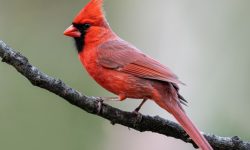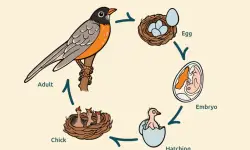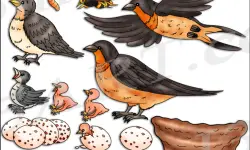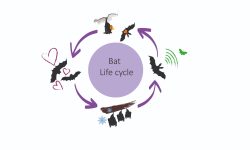There’s something undeniably enchanting about Crested Woodland Birds. With their distinctive head plumes and their affinity for lush, wooded habitats, these birds are a true delight for birdwatchers and nature lovers alike. A quiet walk through a pine forest or a moment by the edge of a woodland can suddenly become magical when one of these crested birds appears.
Crested Woodland Birds come in many shapes, sizes, and colors—from the bold red of a Northern Cardinal to the sleek elegance of a Cedar Waxwing. While each species is unique, they all share one standout feature: a crest of feathers that gives them a regal or sometimes quirky appearance. These crests can signal mood, help with identification, and even play a role in courtship rituals.
This guide showcases 20 stunning Crested Woodland Bird Species, complete with pictures, fascinating facts, and details about their habitats and behaviors. Bird enthusiasts of all levels can enjoy learning more about these charming forest dwellers and how to recognize them in the wild.
Different Types of Crested Woodland Birds
Crested Tit (Lophophanes cristatus)
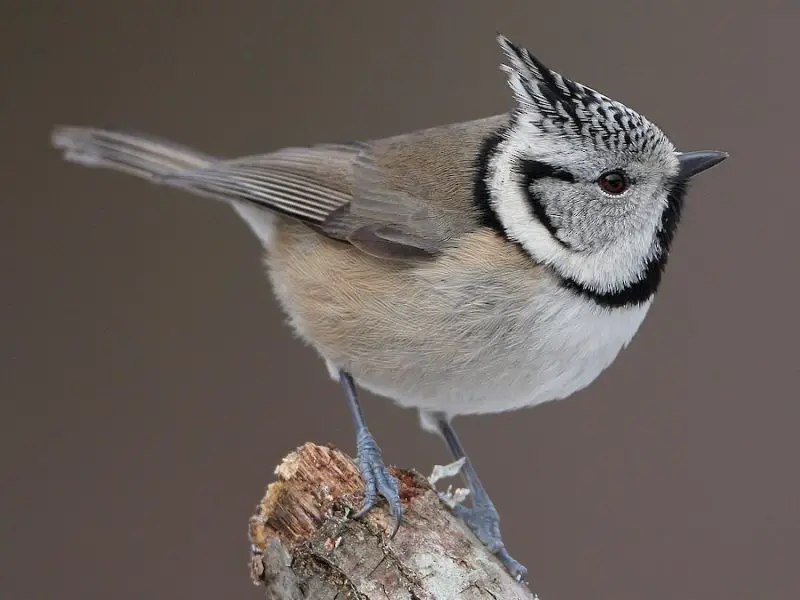
The Crested Tit is a small passerine bird known for its distinctive black-and-white crest that stands upright like a little mohawk. Its plumage includes a soft brown back, whitish underparts, and a prominent black collar that accentuates its crest. This species is often admired for its quirky appearance and energetic behavior.
It is most commonly found in coniferous forests across Europe, especially in the pine and spruce woods of Scandinavia, the Alps, and parts of the British Isles. The Crested Tit is a non-migratory bird, preferring mature forests with plenty of tree cavities for nesting. It is often seen flitting through tree branches in search of food.
Its diet primarily consists of insects, spiders, seeds, and occasionally small berries. During the winter months, it often stores food in tree bark crevices to survive harsh conditions. A fun fact about the Crested Tit is that it can be surprisingly tame around humans, often approaching bird feeders in forested gardens.
Tufted Titmouse (Baeolophus bicolor)
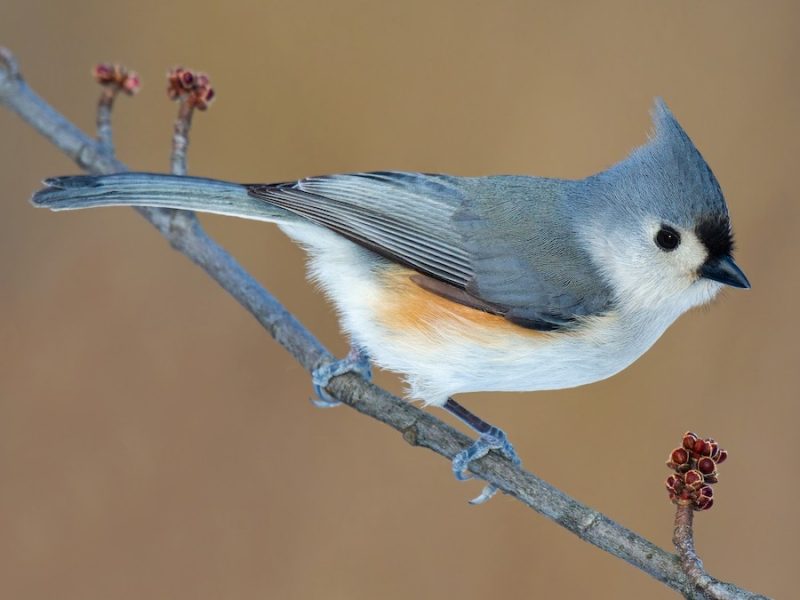
The Tufted Titmouse is a charming and inquisitive bird with a gray crest, large black eyes, and a small but stout bill. Its soft gray upperparts contrast nicely with pale underparts, and it often displays a subtle peach tint along its flanks. This bird is known for its curious nature and clear whistled calls.
Native to deciduous and mixed woodlands across eastern North America, the Tufted Titmouse prefers oak, beech, and maple forests. It often forages in small family groups and can be spotted at backyard feeders, especially during the colder months. These birds nest in tree cavities, often reusing old woodpecker holes or using nest boxes.
The Tufted Titmouse eats a variety of foods including insects, seeds, nuts, and berries. It’s especially fond of sunflower seeds and will stash them in bark crevices or under leaves. A notable behavior is its tendency to pluck hair from live animals such as dogs or squirrels to line its nest, an unusual but well-documented habit.
Northern Cardinal (Cardinalis cardinalis)
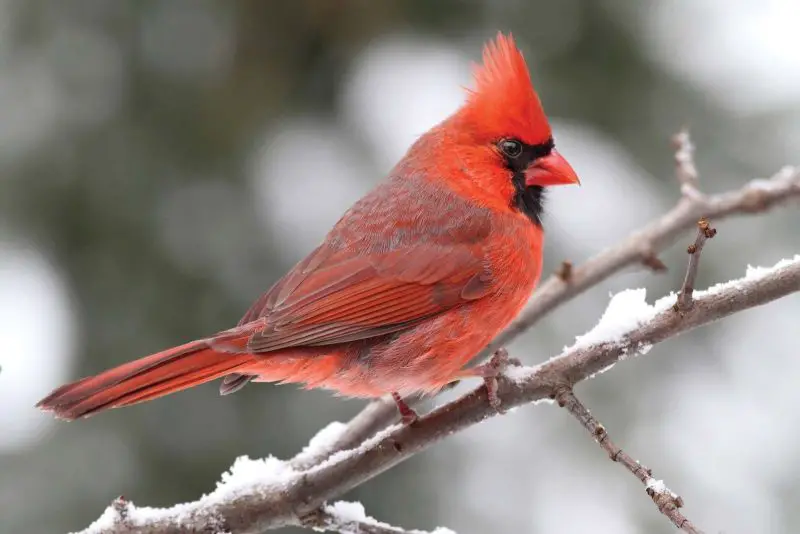
The Northern Cardinal is one of the most recognizable birds in North America, especially the brilliant red males with their striking black face masks and crested heads. Females are more subtly colored in warm brown tones with hints of red, but they share the same distinctive crest and thick orange beak.
This bird is a common resident in woodlands, suburban gardens, thickets, and forest edges throughout the eastern and central United States, parts of Mexico, and even as far north as Canada. Cardinals are non-migratory and are often one of the first birds heard singing in early spring, producing rich, melodic whistles.
Northern Cardinals feed on seeds, fruits, grains, and insects. They are frequent visitors to backyard feeders and particularly enjoy safflower and sunflower seeds. A fun fact is that both males and females sing, which is somewhat rare among North American songbirds, and their songs can vary slightly by region.
Blue Jay (Cyanocitta cristata)
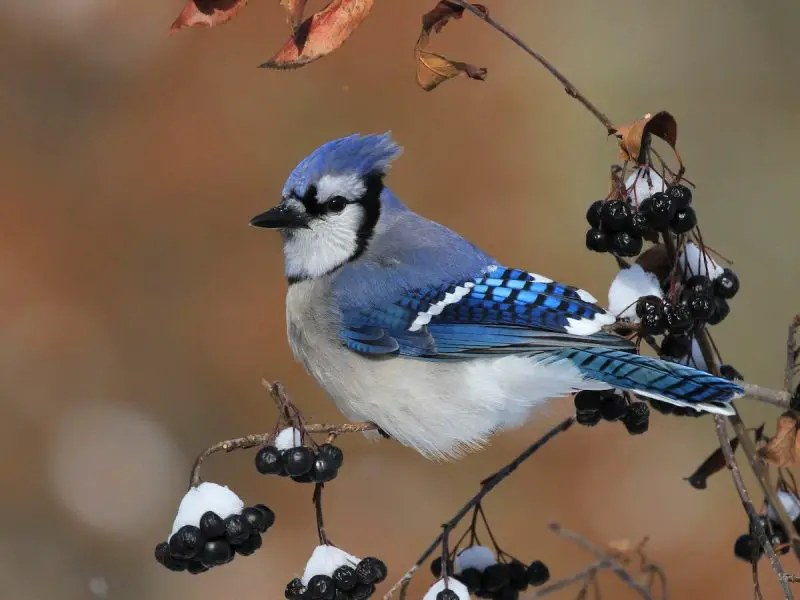
The Blue Jay is a striking bird with vivid blue, white, and black plumage and a prominent crest that it raises or lowers depending on its mood. Its loud, varied calls and intelligence make it both captivating and sometimes controversial among birdwatchers. It has a sturdy black bill and a distinctive black necklace across its throat.
Blue Jays inhabit deciduous and mixed forests across eastern and central North America. They are also commonly found in parks, suburban yards, and wooded urban areas. These birds are known for their bold personalities and are often seen mobbing predators or mimicking hawk calls to scare other birds away from food.
Their diet is highly varied and includes insects, acorns, seeds, grains, and small vertebrates. Blue Jays are known to cache food like acorns for later consumption and play a role in forest regeneration by spreading oak trees. They are also skilled mimics and can imitate the calls of hawks and other birds.
Bohemian Waxwing (Bombycilla garrulus)
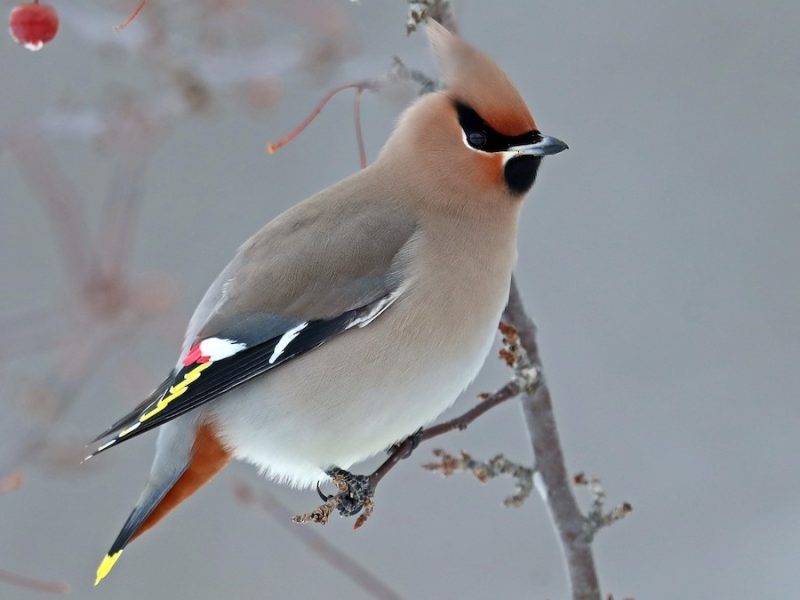
The Bohemian Waxwing is a medium-sized songbird with a silky gray-brown body, black mask, and a soft, swept-back crest that gives it an elegant appearance. Its wings are adorned with white and yellow patterns and red wax-like tips on some feathers, which is where the species gets its name.
These birds breed in the boreal forests of northern Europe, Asia, and North America, often nesting in coniferous trees near water. In winter, they migrate southward in flocks, sometimes appearing in large numbers where fruit is abundant. Their movements are highly irregular and dependent on food availability.
Bohemian Waxwings primarily feed on berries and small fruits like mountain ash, juniper, and crabapple. In summer, they may also eat insects caught in midair. A fascinating fact about them is their ability to eat fermented berries without showing signs of intoxication, though they occasionally appear tipsy when the fruit is especially ripe.
Cedar Waxwing (Bombycilla cedrorum)
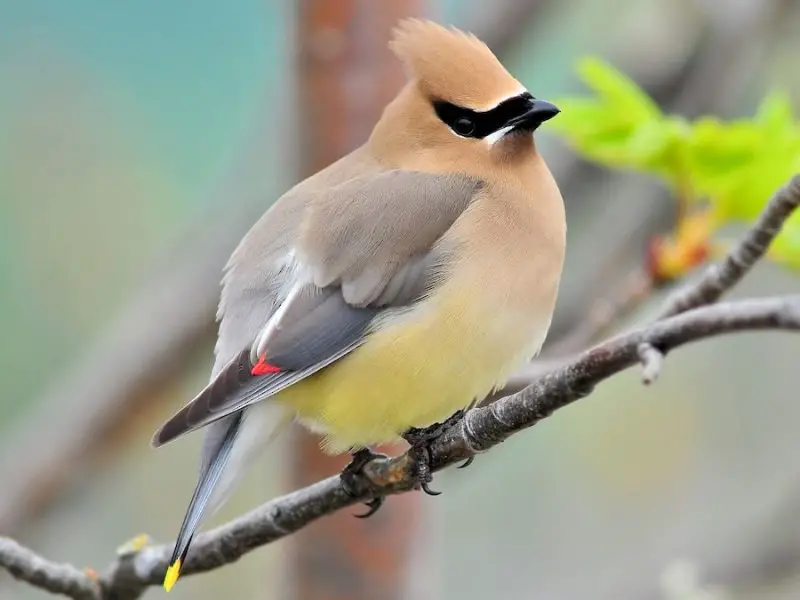
The Cedar Waxwing is a sleek, elegant songbird with a soft, silky plumage in shades of pale brown and gray, accented by a yellow-tipped tail and red wax-like droplets on its wing feathers. Its short crest curves gently backward, adding to its smooth, stylish appearance. A black mask stretches across its face, giving it a striking, masked look.
Native to North and Central America, this species inhabits open woodlands, forest edges, orchards, and even suburban areas. Cedar Waxwings are highly social birds, often seen in flocks that move in graceful unison as they forage for fruit. They breed in northern forests and migrate southward during winter in search of food.
Their diet primarily consists of berries and small fruits, such as serviceberries, dogwood, and cedar berries. In the summer, they supplement their diet with insects. A fun fact is that they sometimes pass berries down a line of birds perched on a branch, sharing before one bird eats. This cooperative behavior is quite rare among songbirds.
Great Crested Flycatcher (Myiarchus crinitus)
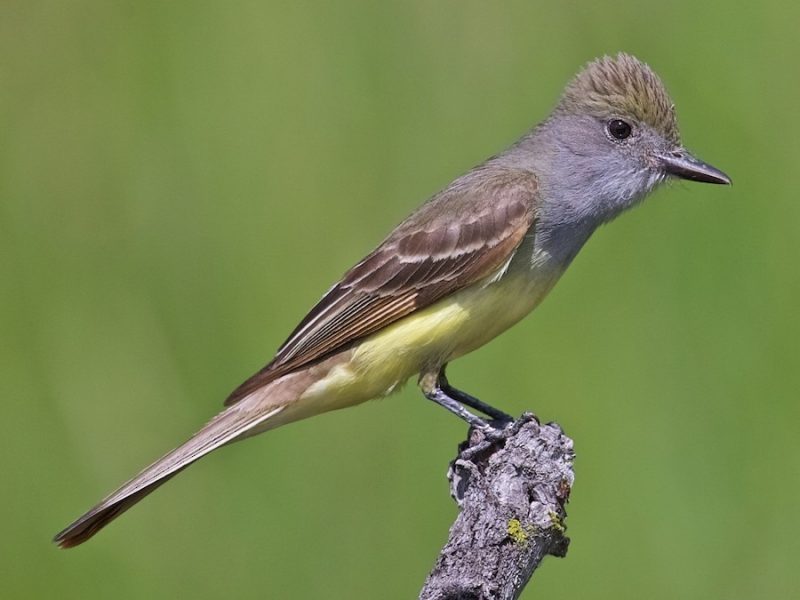
The Great Crested Flycatcher is a large, robust member of the flycatcher family, known for its bold lemon-yellow belly, rufous tail, olive-green upperparts, and a subtly crested head. Its sharp, ringing call is a familiar sound in many wooded habitats during the breeding season. Though not as flashy as other birds, its bright colors stand out in forest light.
This species is native to eastern North America, where it favors deciduous forests, woodland edges, and groves. It nests in tree cavities and readily uses nest boxes when natural sites are scarce. The Great Crested Flycatcher is one of the earliest migratory flycatchers to arrive in spring and among the last to leave in fall.
It primarily feeds on flying insects, which it catches in midair with agile flight maneuvers. It also consumes berries and fruits, particularly in late summer. An interesting fact is that this species often lines its nest with shed snake skins or plastic wrappers—believed to deter predators due to their unusual texture and appearance.
Sulphur-crested Cockatoo (Cacatua galerita)
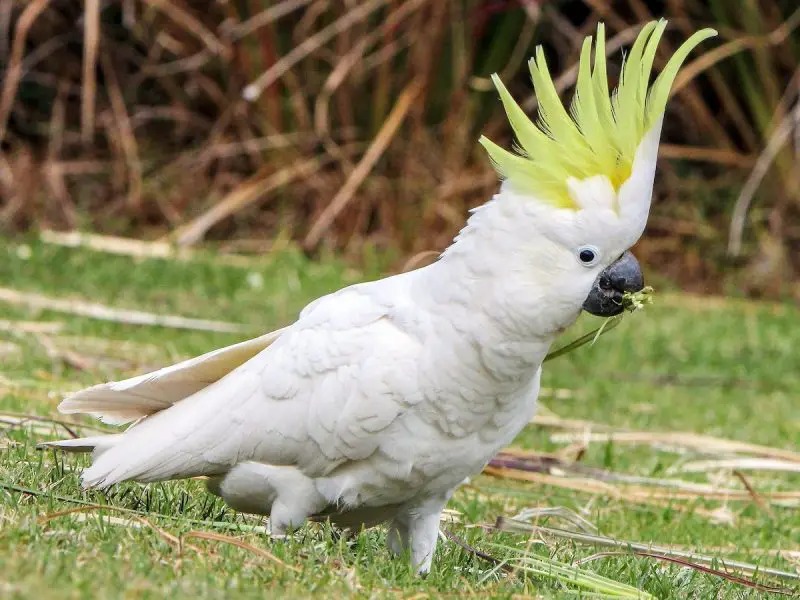
The Sulphur-crested Cockatoo is a large, white parrot known for its dramatic yellow crest, expressive personality, and loud, raucous calls. When excited or alarmed, the bird raises its bright crest in a striking fan shape. Its black bill and dark eyes provide sharp contrast to its white plumage and vibrant crest.
This species is native to Australia and New Guinea, where it inhabits open woodlands, forest edges, and even urban parks. They are highly intelligent and social, often forming noisy flocks that roost in large trees. In cities, Sulphur-crested Cockatoos are known to interact with people, sometimes cheekily dismantling rooftops or power lines.
Their diet includes seeds, nuts, fruits, roots, and occasionally insects. They often forage on the ground or in treetops, using their strong beaks to crack open hard shells. A fascinating trait is their long lifespan—some individuals in captivity have lived over 70 years—and their ability to mimic human speech and sounds.
Red-whiskered Bulbul (Pycnonotus jocosus)
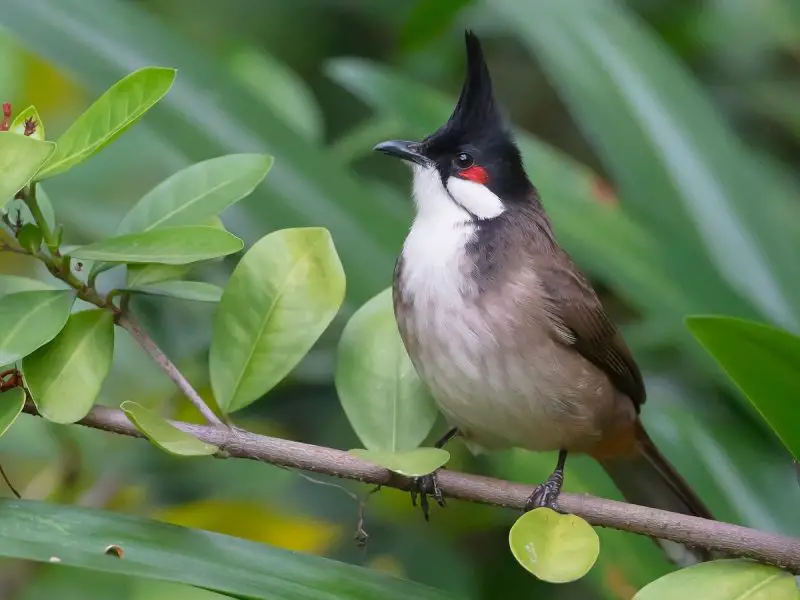
The Red-whiskered Bulbul is a medium-sized songbird with a distinctive black crest, red patches on its cheeks (“whiskers”), and white underparts. Its elegant black crown rises into a tall, pointed crest, while the tail is tipped in white and the vent area is flushed with red. Its soft bubbling call is a familiar sound in many Asian gardens.
This species is widely found across tropical Asia, particularly in India, China, and Southeast Asia, where it inhabits forest edges, gardens, orchards, and scrubby areas. It has also been introduced to other regions, including Florida and some Pacific islands. Red-whiskered Bulbuls prefer habitats with thick vegetation and open perching spots.
They feed on fruits, berries, nectar, and small insects. These bulbuls are often seen in pairs or small groups and are known to be quite adaptable to urban environments. One interesting fact is that in some cultures, they are kept as pets for their pleasant song and bold personalities, though wild populations remain strong.
Crested Lark (Galerida cristata)
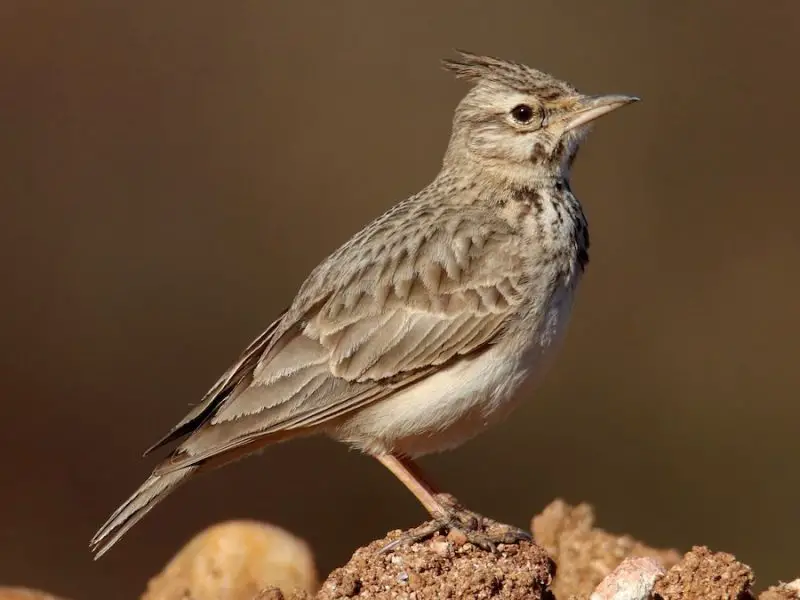
The Crested Lark is a terrestrial songbird with a characteristic spiky crest that it raises when excited or alert. Its brown, streaked plumage provides excellent camouflage in dry, open landscapes. Unlike many other birds with crests, the Crested Lark spends much of its time on the ground, walking rather than hopping.
This species is widespread across Europe, North Africa, and parts of Asia. It prefers open habitats like dry grasslands, woodland clearings, roadsides, and agricultural fields. Crested Larks are often seen singing from rocks, fence posts, or other elevated perches, delivering their melodious and complex songs.
Their diet consists mainly of seeds and insects, foraged from the ground. They are well adapted to arid environments and can survive in areas with minimal vegetation. A notable behavior is their fluttering, parachute-like flight during courtship displays, accompanied by singing that enhances their visibility and vocal performance.
Crested Kingfisher (Megaceryle lugubris)
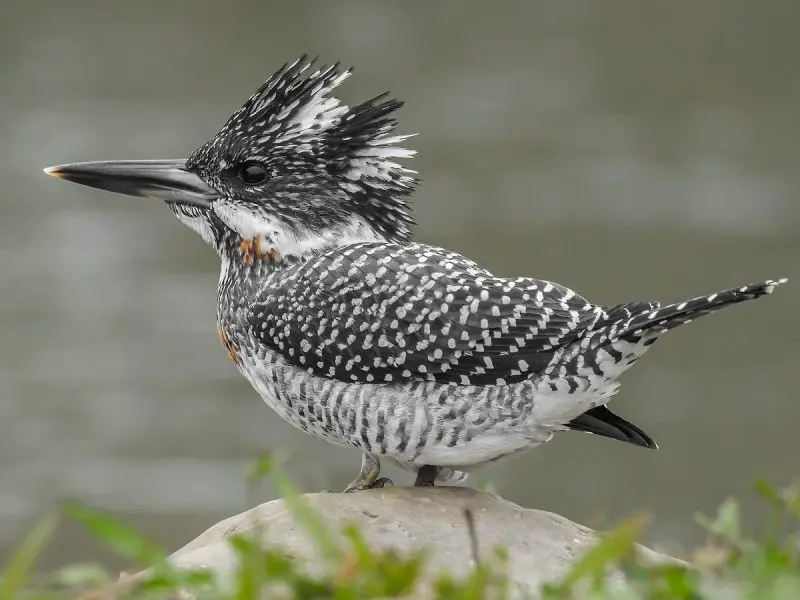
The Crested Kingfisher is one of the largest kingfisher species, known for its striking black-and-white plumage and shaggy crest. Its body is stocky with a large head and an impressive, dagger-like bill ideal for catching fish. The crest gives it a spiky, majestic appearance, especially when raised.
This bird is native to Asia and is typically found along fast-flowing rivers and streams in forested and mountainous areas, especially in regions of India, China, Japan, and Korea. It perches on branches or rocks near the water, always on the lookout for prey. Solitary and shy, it prefers remote habitats away from human disturbance.
The Crested Kingfisher feeds mainly on fish, which it dives for with precision and strength. It may also consume aquatic insects and crustaceans. A fascinating fact is that this bird often nests in burrows dug into riverbanks, sometimes as long as two meters, to protect its young from predators and flooding.
Crested Goshawk (Accipiter trivirgatus)
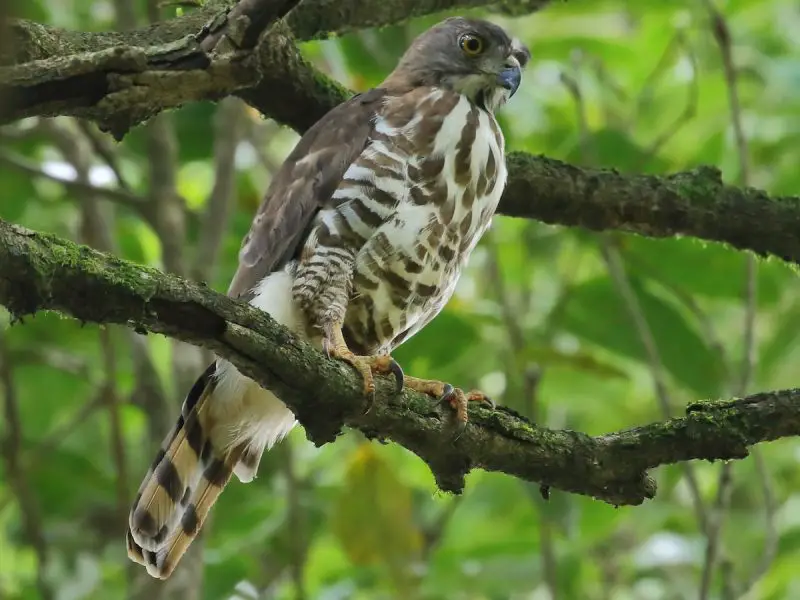
The Crested Goshawk is a medium-sized raptor distinguished by its fine crest, yellow eyes, and bold streaking on the chest. Its compact body and short wings allow for agile flight through dense forest canopies, where it silently hunts its prey. The crest is more visible when the bird is alert or displaying.
This bird of prey is native to South and Southeast Asia and is commonly found in tropical and subtropical forests, including lowland and hill regions. It can also adapt to wooded urban parks and gardens. Despite its forest habitat, it is often elusive and difficult to spot due to its camouflage and stealthy nature.
The Crested Goshawk preys on small birds, reptiles, and mammals, using surprise attacks from perches. It is known for its short, explosive bursts of flight when ambushing prey. A notable behavior is its high-pitched, repeated call, especially during the breeding season, which helps mark territory and attract a mate.
Crested Pigeon (Ocyphaps lophotes)
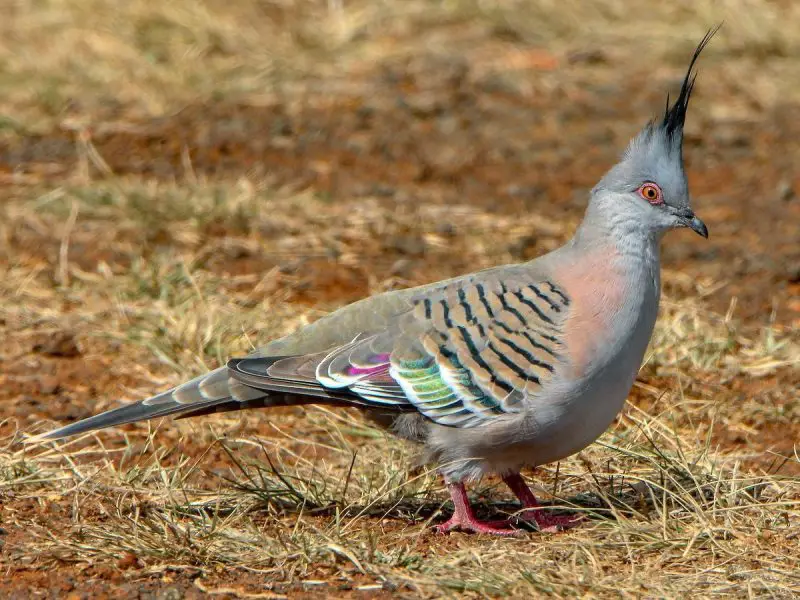
The Crested Pigeon is a slender, grayish bird with a thin black crest that tapers elegantly from the top of its head. Iridescent wing patches shimmer with green and purple when seen in sunlight, and its red eye ring adds a touch of color to its appearance. It is easily recognized by its whistling wing sound in flight.
Native to Australia, the Crested Pigeon thrives in open woodlands, grasslands, farmland, and urban parks. Unlike many pigeons, it is well adapted to dry inland environments and is often seen foraging on the ground in pairs or small groups. It has become a common sight across much of the continent.
Its diet consists mostly of seeds from grasses and weeds, though it will occasionally eat insects. A unique fact about this bird is that it produces a high-pitched whistling noise with each wingbeat when it takes off—believed to be an alarm signal to alert others of danger.
Crested Guineafowl (Guttera pucherani)
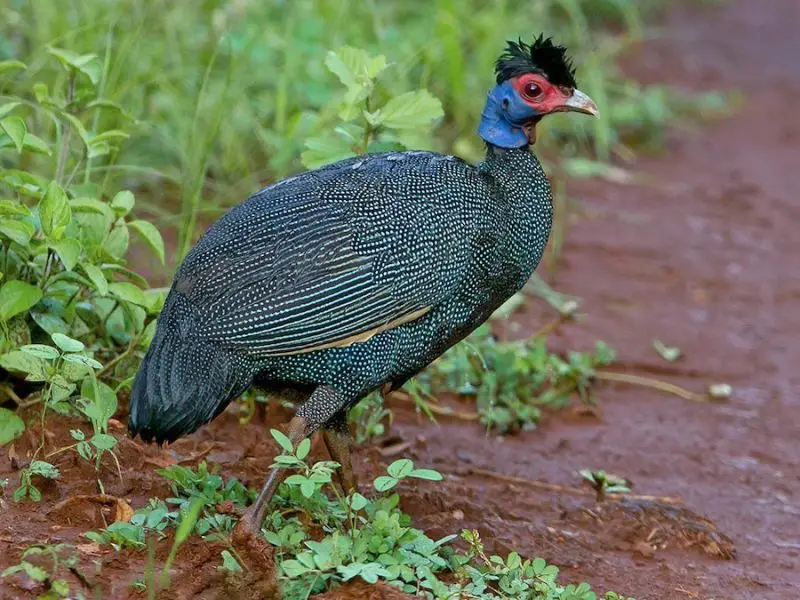
The Crested Guineafowl is a unique and eye-catching bird with a bumpy, curly crest of black feathers on top of its head. Its plumage is dark gray to black and covered with fine white spots, creating a polka-dot effect. Its bare face and bluish skin give it a slightly prehistoric appearance.
Found in sub-Saharan Africa, the Crested Guineafowl inhabits dense forests, especially in regions like the Congo Basin and East Africa. It forages on the forest floor and prefers shaded areas with abundant undergrowth. Though shy and secretive, it moves in small, noisy flocks and communicates through low-pitched calls and clucks.
Its omnivorous diet includes insects, seeds, fruits, and small invertebrates. These birds scratch through leaf litter like chickens while foraging. An interesting fact is that the male and female look nearly identical, and their elaborate courtship includes bowing, circling, and displaying their crest in a curious dance.
Grey-headed Woodpecker (Picus canus)
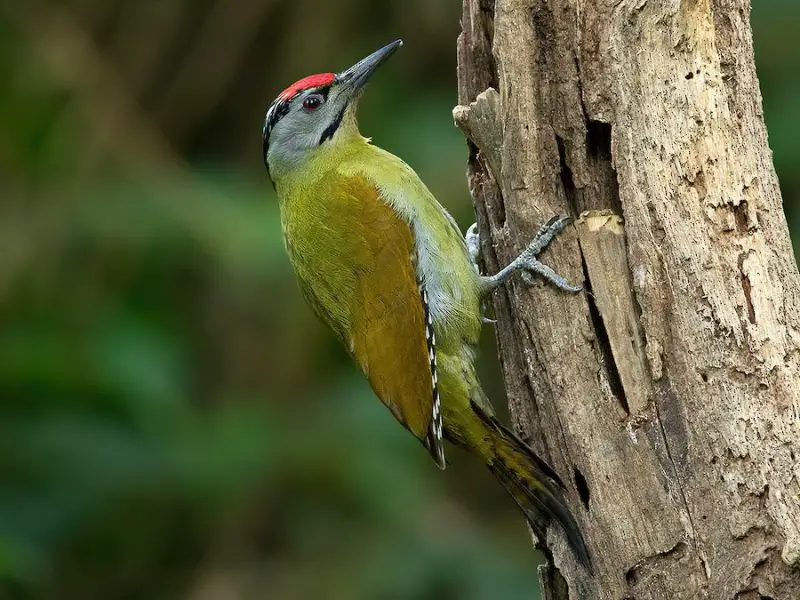
The Grey-headed Woodpecker is a medium-sized woodpecker with soft greenish upperparts and a gray head. Males have a subtle red patch on the crown, giving the illusion of a short crest when raised. The bird has a long, chisel-shaped bill and a slow, deliberate drumming sound on trees.
This species ranges across Europe and parts of Asia, inhabiting deciduous and mixed forests, especially in moist, temperate regions. It prefers large old trees for nesting and foraging and is often seen moving methodically along trunks in search of insects. It is shy and blends easily into its surroundings.
Its diet mainly consists of ants and their larvae, which it extracts from tree bark and rotting wood using its sticky tongue. It may also eat beetles, caterpillars, and occasionally berries in colder seasons. One fun fact is that, unlike some other woodpeckers, it spends more time on the ground feeding on ant colonies than up in the trees.
European Hoopoe (Upupa epops)
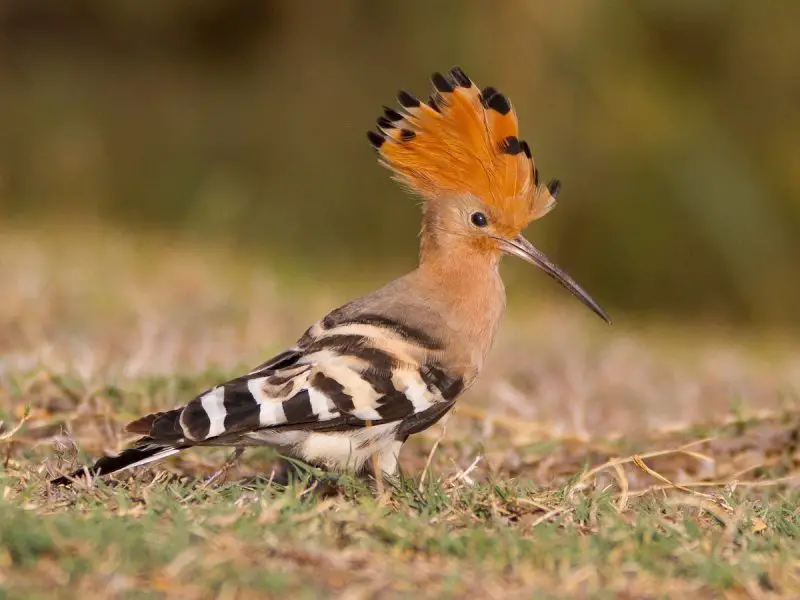
The European Hoopoe is instantly recognizable thanks to its dramatic orange crest tipped in black, which fans open like a crown. Its plumage is a soft cinnamon-pink with striking black-and-white striped wings and tail. Its long, slender, down-curved bill is perfectly adapted for probing into the ground.
This bird is widely distributed across Europe, Asia, and northern Africa, favoring open woodlands, grasslands, orchards, and even gardens. It prefers warm, dry environments with bare or short ground cover where it can hunt for insects. During migration, it may also be found in more varied habitats.
Hoopoes primarily feed on insects such as beetles, ants, crickets, and larvae. They are known to forage by walking slowly on the ground, using their bills to dig and pick prey. A fascinating behavior is their distinctive “oop-oop-oop” call, which gives the bird its name, and their nesting habits in tree cavities or even manmade crevices.
Pileated Woodpecker (Dryocopus pileatus)
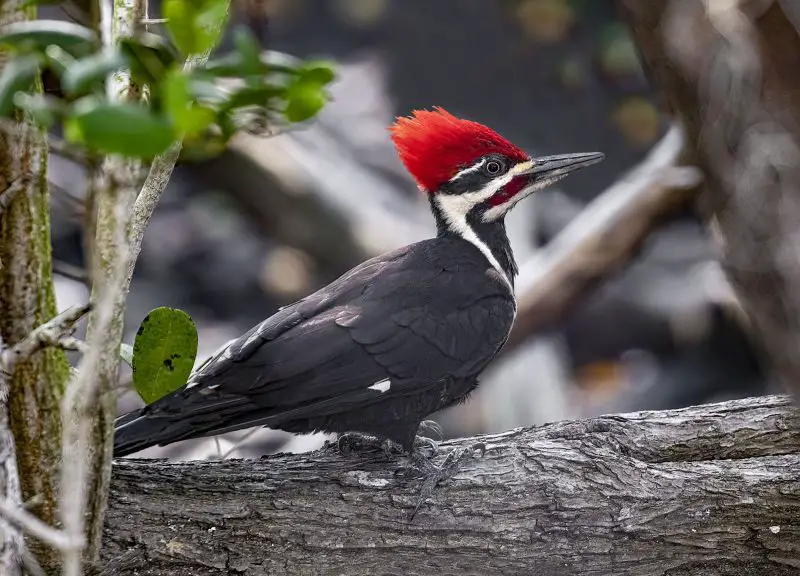
The Pileated Woodpecker is one of the largest woodpeckers in North America, easily identified by its bold red crest and strong black-and-white plumage. It has a distinctive white line down the neck and a heavy chisel-like bill that it uses to excavate rectangular holes in trees.
This species inhabits mature deciduous and mixed forests throughout the eastern United States, parts of Canada, and along the Pacific Coast. It prefers areas with large standing dead trees for nesting and feeding. Often heard before seen, its loud, resonant drumming and sharp calls are key identifiers in the forest.
Its diet includes ants, especially carpenter ants, along with beetle larvae, fruits, and nuts. It is known for leaving large, deep holes in trees when foraging, which also provide shelter for other wildlife. An interesting fact is that Pileated Woodpeckers mate for life and fiercely defend their large forest territories.
Steller’s Jay (Cyanocitta stelleri)
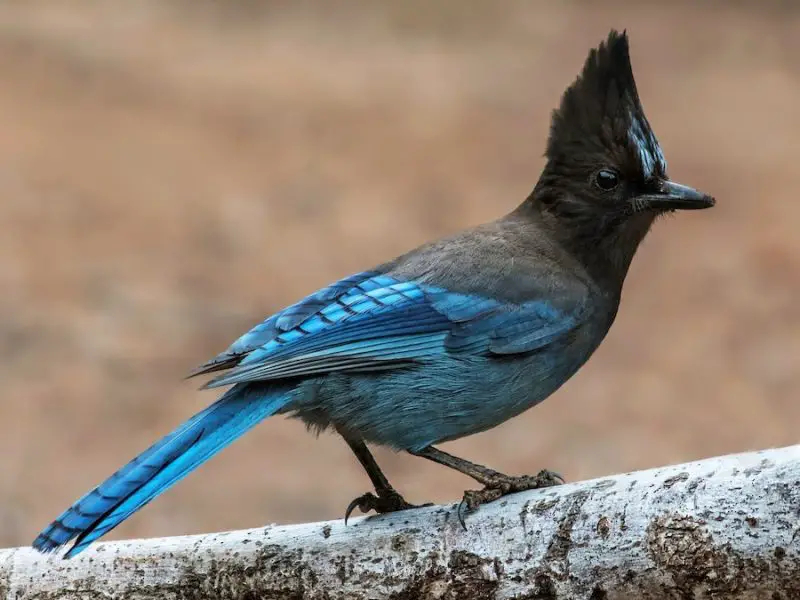
Steller’s Jay is a striking bird of western North America, known for its bold crest, deep blue body, and dark charcoal-black head. The crest is tall and expressive, often raised when the bird is excited or alert. Its brilliant blue wings and tail make it easy to recognize in forested settings.
These jays inhabit coniferous and mixed forests, especially in mountainous regions from Alaska through the western United States and into Central America. They are highly vocal and social, often forming noisy groups. Adaptable to human presence, they are also common in campgrounds and suburban areas near forests.
Omnivorous by nature, Steller’s Jays eat insects, seeds, berries, nuts, and occasionally small animals or bird eggs. They are known for their intelligence and ability to mimic other birds or sounds. One notable behavior is their habit of caching food for later use, which helps them survive harsh winters.
Malabar Grey Hornbill (Ocyceros griseus)
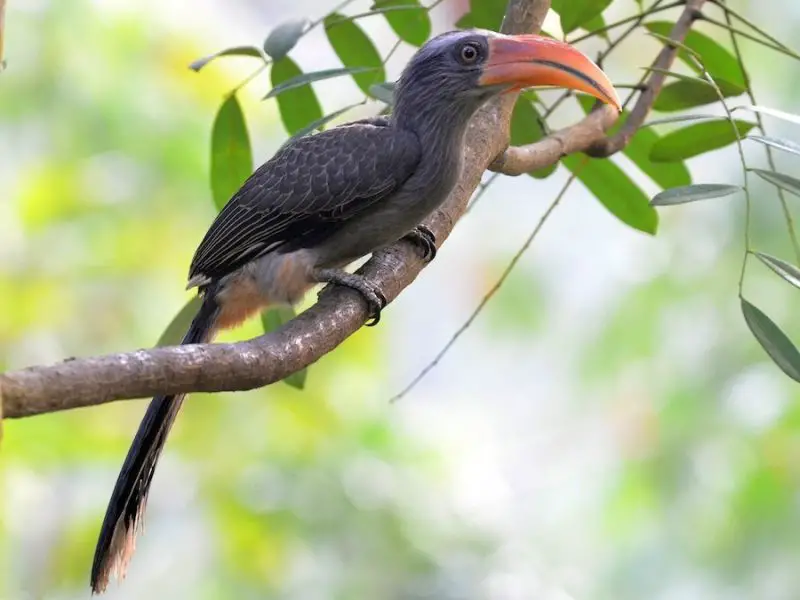
The Malabar Grey Hornbill is a medium-sized bird with a curved yellowish bill and a faint crest of backward-swept feathers. Its plumage is mostly gray with a paler belly and a long tail edged with white. The male’s casque—a hollow structure atop the bill—is more prominent than the female’s.
Endemic to the Western Ghats of southern India, this species inhabits moist deciduous and evergreen forests. It is often seen in pairs or small groups flitting through the canopy or flying with a heavy, undulating motion between trees. Unlike many hornbills, it lacks bright colors but blends well with the forest.
The Malabar Grey Hornbill primarily feeds on figs and other forest fruits, making it an important seed disperser. It also eats insects and small vertebrates. A fascinating fact is that females seal themselves inside tree cavities to nest, using mud and fruit pulp, leaving only a narrow slit through which the male feeds them.
Philippine Eagle (Pithecophaga jefferyi)
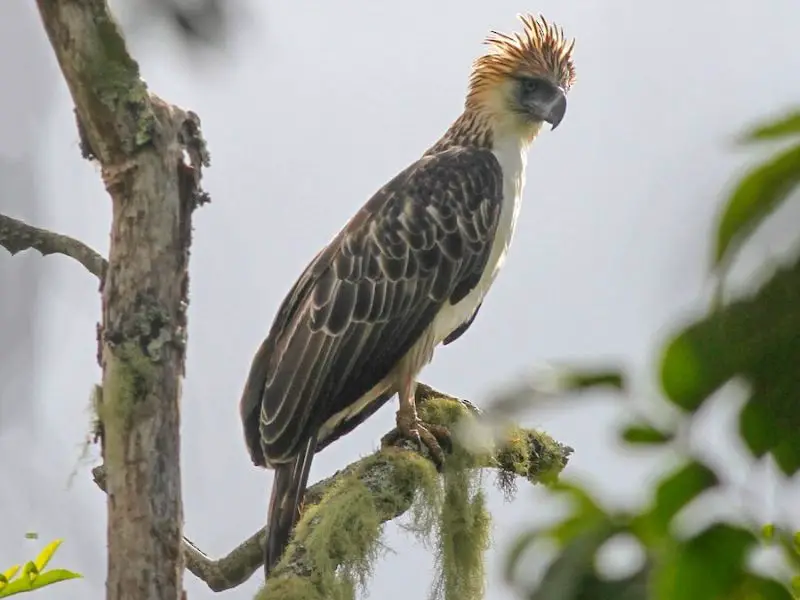
The Philippine Eagle is a massive and majestic bird of prey with a shaggy, spiked crest that adds to its imposing presence. Its powerful build, large bill, and piercing blue-gray eyes contribute to its fearsome appearance. It is considered one of the world’s largest and most powerful eagles.
This critically endangered species is endemic to the Philippines, where it lives in the last remaining patches of lowland and montane tropical rainforests on islands like Mindanao, Luzon, and Leyte. It requires vast territories of pristine forest to hunt and breed, making habitat loss its greatest threat.
Primarily a carnivore, the Philippine Eagle preys on monkeys, flying lemurs, birds, and reptiles. It is solitary and territorial, with nesting pairs maintaining large home ranges. A compelling fact is that it lays only one egg every two years, and both parents participate in raising the chick—a key reason its population remains so low.

